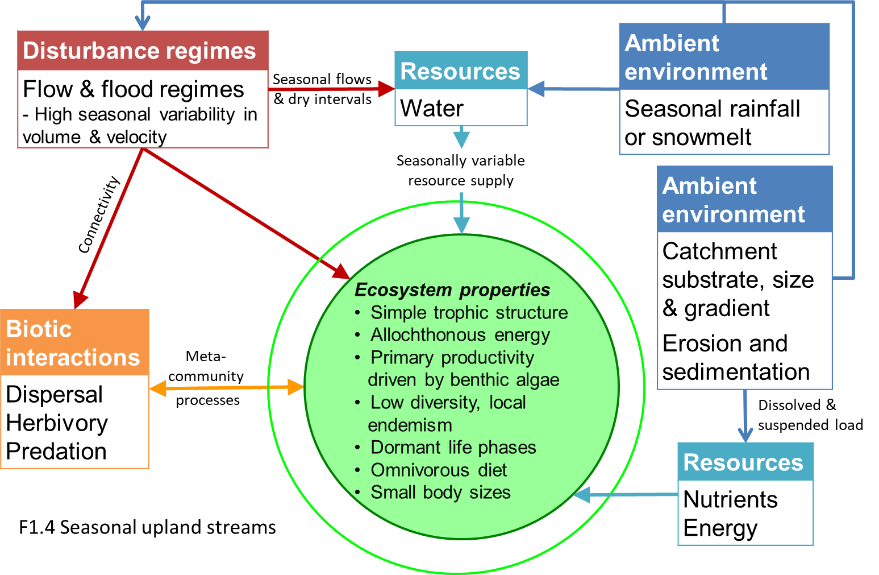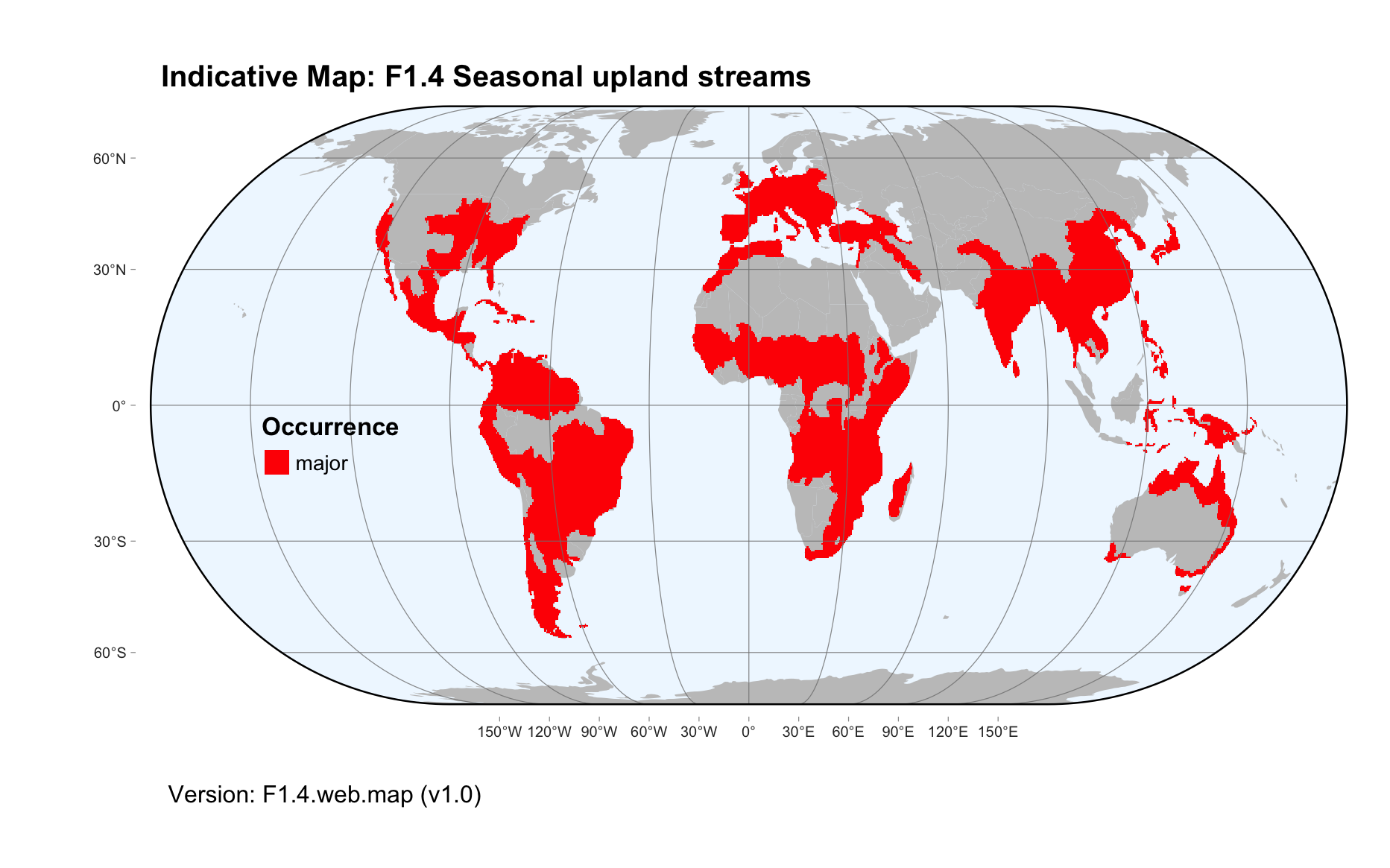Global ecosystem typology
Alternative site for the Global ecosystem typology with additional information for ecosystem profiles and indicative maps.
This site is maintained by jrfep
F1.4 Seasonal upland streams
Biome: F1. Rivers and streams biome
Contributors:
(texts)
Seasonal rainfall patterns in large parts of the tropics and temperate regions generate flows that are hugely variable in narrow and steep upland streams. Globally, these streams account for the greatest stream length of any flowing ecosystem. During the dry season, flows in some streams are reduced to very levels, while in others flow ceases altogether and water persists only in isolated stagnant pools. Algae and leaf fall support moderate productivity, with seasonal floods sending organic matter downstream. The diversity of organisms fluctuates seasonally, with many localised (endemic) species, and specialised adaptations that enable animals to survive both flooding and dry conditions.
Key Features
High-medium velocity, low-medium volume, highly seasonal flows with abundant benthic filter feeders, algal biofilms & small fish.
Overview of distribution
Extensive in wet-dry tropics and temperate zones.
Profile versions
- v1.0 (2020-05-30): RT Kingsford; DA Keith
- v2.0 (2020-06-24): RT Kingsford; B Robson; PS Giller; AH Arthington; M Kelly-Quinn; DA Keith
- v2.01 ():
- v2.1 (2022-04-06): RT Kingsford; B Robson; PS Giller; AH Arthington; M Kelly-Quinn; DA Keith Full profile available at official site
Main references
Selected references for this functional group:
Davies PM, Bunn SE, Hamilton SK (2008) Primary production in tropical streams and rivers Tropical stream ecology (Ed. D Dudgeon), pp. 23–42. Academic Press, London DOI:10.1016/b978-012088449-0.50004-2
de Carvalho RA., Tejerina-Garro FL. (2018) Headwater-river gradient: trait-based approaches show functional dissimilarities among tropical fish assemblages Marine and Freshwater Research 69: 574-584 DOI:10.1071/mf17149
Datry T, Bonada N, Boulton A (2017) Intermittent rivers and ephemeral streams: ecology and management (Academic Press: Burlington)
Jardine RD, Bond NR, Burford MA, Kennard MJ, Ward DP, Bayliss P, Davies PM, Douglas MM, Hamilton SK, Melack JM, Naiman RJ, Pett NE, Pusey BJ, Warfe DM, Bunn SE (2015) Does flood rhythm drive ecosystem responses in tropical riverscapes? Ecology 96, 684–692 DOI:10.1890/14-0991.1
Diagrammatic assembly model

Maps
Maps are indicative of global distribution patterns are not intended to represent fine-scale patterns. The maps show areas of the world containing major (coloured red) or minor occurrences (coloured yellow) of each ecosystem functional group. See general notes on maps.
There are 2 alternative versions of the indicative map for this functional group, please compare description and sources below.
F1.4.IM.grid_v2.0
Datasets
- HydroAtlas-1.0
- FEOW-2008
Map references
Linke, S., Lehner, B., Ouellet Dallaire, C., Ariwi, J., Grill, G., Anand, M., Beames, P., Burchard-Levine, V., Maxwell, S., Moidu, H., Tan, F., Thieme, M. (2019) Global hydro-environmental sub-basin and river reach characteristics at high spatial resolution Scientific Data 6: 283 DOI:10.1038/s41597-019-0300-6
Abell R, Thieme ML, Revenga C, Bryer M, Kottelat M, Bogutskaya N, Coad B, Mandrak N, Contreras Balderas S, Bussing W, Stiassny MLJ, Skelton P, Allen GR, Unmack P, Naseka A, Ng R, Sindorf N, Robertson J, Armijo E, Higgins JV, Heibel TJ, Wikramanayake E, Olson D, López HL, Reis RE, Lundberg JG, Sabaj Pérez MH, Petry P (2008) Freshwater ecoregions of the world: A new map of biogeographic units for freshwater biodiversity conservation, BioScience 58: 403–414. DOI:10.1641/B580507
F1.4.web.map_v1.0

Datasets
- FEOW-2008
- HydroAtlas-1.0
Map references
Abell R, Thieme ML, Revenga C, Bryer M, Kottelat M, Bogutskaya N, Coad B, Mandrak N, Contreras Balderas S, Bussing W, Stiassny MLJ, Skelton P, Allen GR, Unmack P, Naseka A, Ng R, Sindorf N, Robertson J, Armijo E, Higgins JV, Heibel TJ, Wikramanayake E, Olson D, López HL, Reis RE, Lundberg JG, Sabaj Pérez MH, Petry P (2008) Freshwater ecoregions of the world: A new map of biogeographic units for freshwater biodiversity conservation, BioScience 58: 403–414. DOI:10.1641/B580507
Linke, S., Lehner, B., Ouellet Dallaire, C., Ariwi, J., Grill, G., Anand, M., Beames, P., Burchard-Levine, V., Maxwell, S., Moidu, H., Tan, F., Thieme, M. (2019) Global hydro-environmental sub-basin and river reach characteristics at high spatial resolution Scientific Data 6: 283 DOI:10.1038/s41597-019-0300-6
Check: the Glossary / Profile structure / the public document